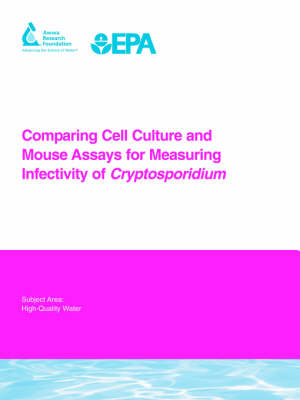Water Research Foundation Report
1 total work
Comparing Cell Culture and Mouse Assays for Measuring Infectivity of Cryptosporidium
by Paul A Rochelle, Marilyn M. Marshall, Jane Mead, and J. S. Rosen
Published 30 June 2005
Cell culture techniques are routinely used for measuring the infectivity of a wide range of human pathogens. A variety of different cell culture systems and detection methodologies have been applied to Cryptosporidium parvum. However, the correlation between cell culture methods and animal infectivity assays has not been thoroughly investigated. Although many cell culture methods have been developed for C. parvum, it has not been proven that infectivity in cell culture is a good indicator of the ability of oocysts to cause infections in animals. The objective of this research was to compare in-vitro cell culture methods with a mouse assay for measuring infectivity of C. parvum oocysts. The specific objectives were to (1) compare the dose response and sensitivity of cell culture and mouse assays with multiple isolates; (2) compare infectivity methods with oocysts exposed to environmental water samples; (3) determine the reproducibility and variability of the methods; and (4) compare cell culture and animal assays for assessing ozone and UV disinfection.For untreated oocysts, challenge doses were enumerated by flow cytometry. Dose response curves were constructed by regression analysis of oocyst dose against a logistic transformation of the proportional infectivity and the 50% infectious doses for each isolate were calculated by solving the regression for a logit value of zero. Infections in CD-1 mice were detected by microscopy following staining with hematoxylin and eosin. Infection in HCT-8 and Caco-2 cells was detected by C. parvum-specific RT-PCR. In MDCK cells, infection was detected using immunofluorescence. For disinfection studies, oocysts were exposed to UV using a medium-pressure, collimated beam apparatus and inactivation was measured as the difference in ID50 of unexposed and UV-exposed oocysts. Oocysts were exposed to ozone using batch, semi-batch, and single continuously stirred tank reactors at 1, 5, and 15°C.This investigation demonstrated that in-vitro cell culture was equivalent with a mouse assay for measuring infectivity of untreated C. parvum oocysts and should therefore be considered a practical alternative for assessing the potential of oocysts to cause infection. However, the high levels of variability displayed by mouse and cell culture methods indicated that infectivity and disinfection experiments should be limited to discerning relatively large differences. Of the three cell culture assays, the HCT-8/RT-PCR method displayed the closest agreement with the CD-1 mouse assay. C. hominis was infectious in HCT-8 cells but did not infect mice. Similar results were obtained with CD-1 mice and HCT-8 cells for measuring infectivity of oocysts that had been exposed to environmental water for 35 days. There was also very good agreement between HCT-8 cell culture and CD-1 mouse assays for measuring UV inactivation of C. parvum. A medium-pressure UV dosage of 5.6 mJ/cm2 resulted in 2-log10 inactivation. The shapes of ozone inactivation curves were generally the same for mouse and cell culture derived data although the CD-1 mouse assay typically generated 0.5 to 1-log10 higher levels of inactivation than HCT-8 cells. In addition, there was a stimulatory response in oocysts exposed to ozone below 20 mg.min/L when assayed by HCT-8 cell culture. Consequently, further research is necessary to understand the response of oocysts to ozone when inactivation is assessed by cell culture methods. The water industry should adopt in-vitro cell culture as a routine method for measuring the infectivity of waterborne C. parvum and C. hominis oocysts. This project has demonstrated that cell culture has equivalency with the standard CD-1 mouse assay and cell culture assays can be applied to oocysts recovered from water using approved methods. However, there needs to be a thorough, robust, and well-controlled study to compare the various cell culture-based assays for measuring C. parvum and C. hominis infectivity. This evaluation should include inter-laboratory comparisons and round-robin testing. Cell culture-based assays should also be used to assess disinfection of C. hominis isolates. Originally published by AwwaRF for its subscribers in 2004. This publication can also be purchased and downloaded via Pay Per View on Water Intelligence Online - click on the Pay Per View icon below
